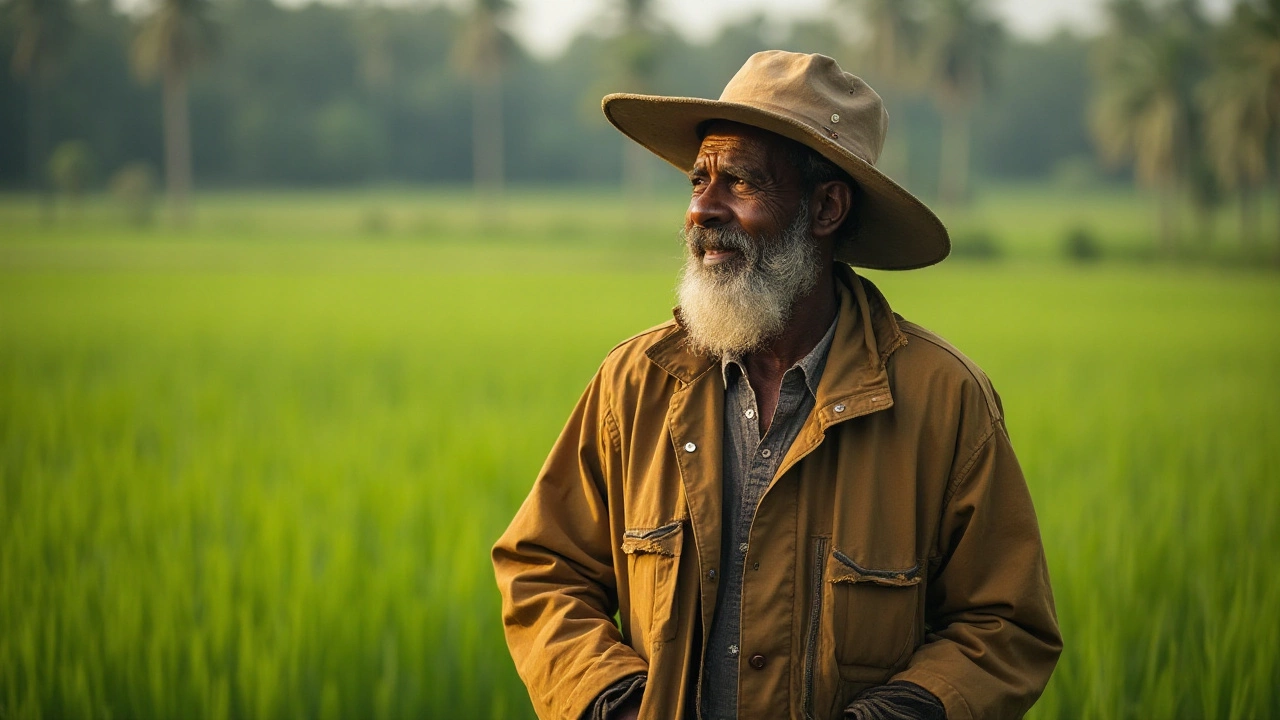Top Jackets Comparable to Carhartt: Durable Alternatives for Every Season

When it comes to reliable workwear, Carhartt jackets have built a reputation for being tough, dependable, and stylish. They're the go-to choice for many who need durable outerwear. But what if you're in search of something just as good that's not as mainstream?
Luckily, the world of jackets is vast, and there are plenty of brands that offer pieces just as hardy and functional. These alternatives often bring unique features, materials, and styles to the table, appealing to those who want something a little different yet equally durable.
From classic heritage brands to newer companies making waves, there's no shortage of quality outerwear to consider. Let's dive into some jackets that give Carhartt a run for its money, ensuring you stay protected against the elements without sacrificing style or substance.
- Key Features of Carhartt Jackets
- Best Brands Offering Durable Alternatives
- Comparing Materials and Construction
- Tips for Choosing the Right Jacket
Key Features of Carhartt Jackets
Carhartt jackets have long been a staple in the world of workwear, boasting an impressive combination of durability, comfort, and style. These jackets are constructed with heavy-duty fabrics such as duck cotton and sandstone that stand up against the toughest of conditions, from construction sites to outdoor adventures. The special weaving techniques used in their fabrics are well-known for providing high resistance to wear and tear, making them ideal for those who require dependable apparel day in and day out. It’s not just about the outer shell though; the interior linings, often quilted or insulated, add a layer of warmth perfect for cold environments, showing Carhartt's commitment to both function and comfort.
Another standout feature is the reinforced stitching and seams which enhance the longevity of their products. Many Carhartt jackets incorporate triple-stitched main seams which reduce fraying and splitting along these stress points. This kind of meticulous craftsmanship ensures that a Carhartt jacket often outlives many of its competitors. With designs tailored to fit comfortably without restricting movement, they enable users to carry out physical activities smoothly, which is especially important in work settings. The availability of multiple pockets, designed functionally, provides ample room for tools and other essentials, a hallmark of the brand that suits professionals.
According to a review published by Outdoor Gear Lab, "Carhartt jackets have proven time and again that they can withstand rugged use while offering practical features that enhance user experience."
Moreover, Carhartt has paid attention to adverse weather conditions by incorporating features like water-repellent finishes. This feature helps workers and outdoor enthusiasts remain dry in drizzle and light rain. The brand includes adjustable drawstring hoods and cuffs, ensuring a snug fit to keep the elements out. Additionally, Carhartt offers a wide range of styles, from traditional barn coats to modern bomber jackets, allowing wearers to find a look that matches both their functional needs and personal tastes. These options cater to different climates and work environments, truly showcasing their versatility.
Despite being rooted in workwear heritage, Carhartt manages to blend functionality with a somewhat understated design that appeals to a wider audience beyond blue-collar workers. Their seamless blend of practical design with stylish elements like sleek silhouettes and classic colors makes them an appealing choice for everyday wear as well. This versatility, combined with their commitment to quality, is what sets Carhartt jackets apart and solidifies their reputation in the industry. Whether you’re driving a tractor or just heading out in brisk weather, the reliability of a Carhartt jacket is something countless users swear by.

Best Brands Offering Durable Alternatives
When seeking an alternative to Carhartt in the world of rugged outerwear, it’s important to consider brands that have been trusted for their quality and durability. One such brand is Patagonia, renowned not only for its sustainable practices but also for producing jackets that withstand harsh weather without compromising on comfort. Patagonia’s Iron Forge Hemp Canvas jackets, for example, provide incredible durability, catering to those who demand practicality combined with environmentally conscious materials.
Next on the list is Filson, a staple in heritage outerwear. Known for their meticulous craftsmanship, Filson jackets are made from tough materials like tin cloth and Mackinaw wool, ensuring they stand up to the test of time. These jackets offer a vintage aesthetic with modern-day functionality, making them a preferred choice for those who appreciate both style and substance. Filson’s emphasis on producing products in the U.S. aligns with the preferences of those supporting local manufacturing while seeking high-quality garments.
Another formidable competitor is The North Face, a brand synonymous with exploration and adventure. Their commitment to innovation is evident in jackets like the Apex Flex Futurelight, which boasts breathable and waterproof technology. Designed for active lifestyles, The North Face ensures their outerwear is up to par with the demands of the outdoors, offering comfort and flexibility without sacrificing performance.
A noteworthy mention is Dickies, a brand often paralleled with Carhartt regarding workwear. Dickies jackets are known for practicality in rugged environments, prioritizing functionality with designs like the Eisenhower Jacket. Made from resilient materials, these jackets promise durability and comfort for those working in demanding settings.
According to outdoor gear expert, "A good jacket is an investment in comfort and durability. Brands like these ensure your jacket isn't just another piece of clothing but a reliable companion through various adventures."
Below is a comparison table highlighting some key features of these brands’ standout jackets:
| Brand | Model | Material | Unique Feature |
|---|---|---|---|
| Patagonia | Iron Forge Hemp Canvas | Hemp, recycled polyester | Eco-friendly materials |
| Filson | Tin Cloth Jacket | Tin cloth | Water-repellent coating |
| The North Face | Apex Flex Futurelight | Polyester, elastane | Breathable, waterproof |
| Dickies | Eisenhower Jacket | Poly-cotton blend | Industrial strength seams |
Each of these brands presents jackets with distinctive qualities that may appeal to various personal tastes and needs. Whether your priority is sustainability, craftsmanship, or high-performance under extreme conditions, these brands offer jackets that rival Carhartt’s esteemed durability and reputation.

Comparing Materials and Construction
When choosing an alternative to a coveted Carhartt jacket, the material and construction of the jacket are key aspects to consider. Carhartt is often revered for its heavy-duty fabrics like duck cotton, known for its resilience against wear and tear, and its precision in triple-stitched seams which reduce the likelihood of fraying and ripping. As we explore comparable alternatives, understanding these elements can guide you in finding a jacket that’s just as tough and reliable.
Fabrics used in these jackets typically include canvas, nylon, and sometimes a blend of synthetics to enhance durability while maintaining comfort and flexibility. For instance, nylon is commonly used due to its impressive resistance to abrasion and ability to repel water, making jackets a preferred choice for cold and wet environments. Canvas, being a heavyweight fabric, is known for its longevity, making it similar to Carhartt's signatures. These materials ensure that jackets withstand challenging conditions over extended periods. A well-constructed collar can also be a mark of quality, preventing the jacket from wearing out quickly.
According to Wear and Gear magazine, "A jacket's performance is heavily influenced by its stitching quality and material sturdiness. Brands that echo Carhartt's legacy often use reinforced seams along with tailored fits to deliver robust wear. This ensures that the jackets not only protect but also offer a great deal of mobility."
Looking at the construction, the design elements such as reinforced elbows, storm flaps over zippers, and adjustable cuffs are essential features to note. These features play a crucial role in shielding against extreme weather conditions while offering ventilation when needed. Jackets often highlight the use of double weaving techniques, adding layers of fabric to enhance both moisture-wicking and thermal insulation properties. Additionally, some variants come with gusseted underarms or articulated sleeves, emphasizing versatility for active movements.
Ideal jackets also incorporate a blend of modern technology with traditional craftsmanship, like water-resistant coatings and insulated linings, which are crucial during colder months. For example, some brands use advanced DWR (Durable Water Repellent) coatings, ensuring the jacket remains breathable while repelling moisture. For insulation, look for synthetics or responsibly sourced down fillings that trap heat effectively without adding extra bulk.
For enthusiasts seeking workwear that stands up to the elements, exploring these materials and construction nuances in jackets beyond the Carhartt shelf often yields rewarding options. Many brands deliver combinations of cutting-edge technologies and time-tested techniques that offer excellent protection, comfort, and, importantly, longevity. With this knowledge, finding the perfect alternative jacket becomes less daunting and more a testament to smart shopping for durable apparel.

Tips for Choosing the Right Jacket
Picking the right jacket is an important decision that impacts not just your wardrobe aesthetics, but also comfort and performance in various weather conditions. First, assess your specific needs. Are you searching for something similar to Carhartt for heavy-duty work? Or perhaps you need a jacket suitable for casual wear with a durable edge. Consider the climate you are facing; a thick, insulated jacket is perfect for colder regions, while those in milder areas might opt for something lighter. Pay attention to versatility as well: jackets featuring removable liners or hoods offer adaptability across different seasons.
Attention to fabric is crucial. The right material can make a significant difference in durability and comfort. For instance, cotton duck and polyester blends often hold up well against wear and tear, which is why they are staples in workwear. Also, inspect the construction details such as reinforced stress points and quality of zippers, ensuring ease of use and longevity. Waterproof and wind-resistant materials offer extra protection against the elements, particularly if you're outdoors often.
Functionality is another essential factor. Evaluate if the jacket offers enough pockets and closures for your needs, especially if you're using it for work. Interior and exterior pockets can be a game changer for carrying tools or personal items. Some jackets also feature hand-warmer pockets, which are a nice touch for colder climates. When prioritizing practicality, a jacket that balances utility with style can serve both daily chores and leisure activities effectively.
"Quality means doing it right when no one is looking," says Henry Ford. This underscores the importance of not just picking based on looks, but paying attention to the unseen aspects that assure durability and function over time.
Consider the brand's reputation and reviews from those who have similar needs. User feedback can provide insight on how jackets perform in real-world settings. Sometimes well-established brands known for durable jackets have a deeper understanding of what works over seasons. And while prices can be indicative of quality, it's wise to find a balance. Look for jackets that offer a good warranty or repair options to ensure your investment lasts.
Here's a simple guide to help you make an informed decision:
- Identify the primary use: work, casual, or multipurpose.
- Choose the suitable material: consider weather resistance and robustness.
- Check functional design: assess pockets, closures, and removable components.
- Review customer feedback and brand reputation.
- Consider price-to-value ratio and post-purchase support.
Choosing the right jacket is more than just a style choice; it's about finding the right companion for your lifestyle and needs. These tips should ease the process, ensuring you end up with a jacket as reliable and stylish as a Carhartt alternative.
- Dec, 11 2024
- Violet Greenfield
- 0
- Permalink
Written by Violet Greenfield
View all posts by: Violet Greenfield